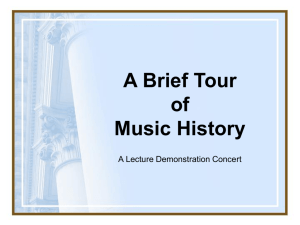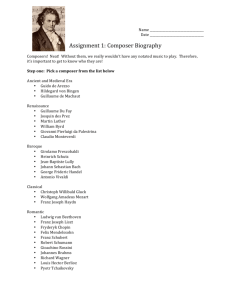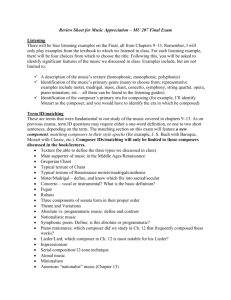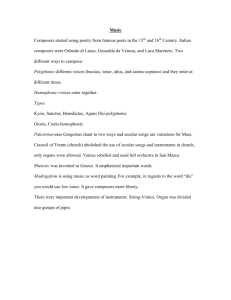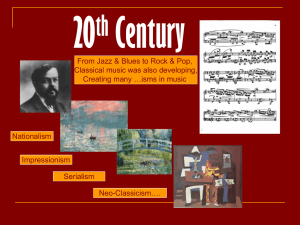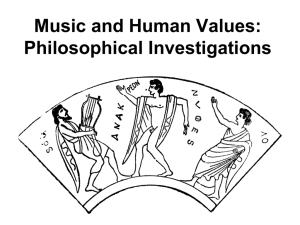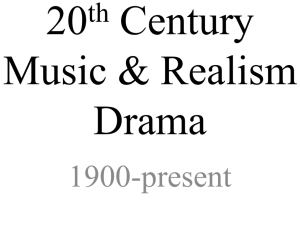File - Durand Choirs
advertisement
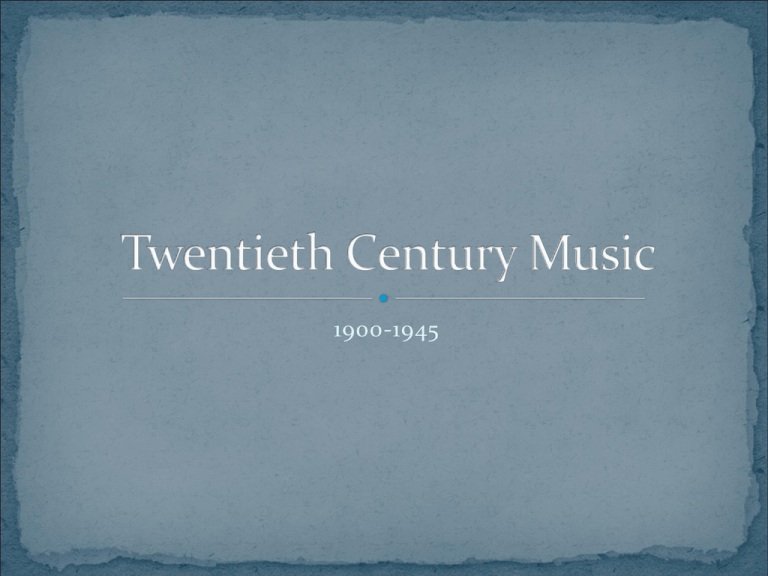
1900-1945 Two world wars! Civil rights New technologies: sound recordings, movies, radios, telephones, satellites, and computers created a revolution in communication. Shock was the goal of art in the time. Modern dance clashed with classical ballet Artist like Picasso distorted figures in paintings Art=mood or emotion, NOT literal things Technology inspired all forms of art Plastic, fluorescent lights and TV monitors in visual arts Audiotapes, synthesizers, and computers for musicians Concerns of minorities and woman show up in all arts All art forms are impacted by the tragedy of world wars and destructions Sigmund Freud, Interpretation of Dreams (1900) Albert Einstein, special theory of relativity (1905) First World War (1914-1918) Russian Revolution (1917) Great Depression (1929) Hitler appointed chancellor of Germany (1933) Second World War (1939-1945) Atomic Bomb destroys Hiroshima (1945) The twentieth century was a time of revolt. Composers question what can be considered music The answer= ANYTHING! Musical Styles: 1900-1945 Folk songs! New recording technology= composers record peasant music for their compositions Bela Bartok and Igor Stravinsky- researched folk songs Charles Ives- church music Musical Styles: 1900-1945 Non-Western music had a big impact on composers of this time Non-Western refers to music that did not develop in Europe, USA or surrounding countries Interested in Asian, African, Latin and Indian music Jazz Music- big inspiration for all composers Music Styles: 1900-1945 Scholars and historians discover old composer’s music. This enables new composers to study it Remember, Antonio Vivaldi (who wrote The Four Seasons) was not even discovered until the 1900’s. Characteristics of 20th Century Music Tone color became very important! Instruments picked for their individual sound Percussion instruments became very important! Anything is now a percussion instrument (typewriters, car horns, canons.) Composers write music just for a percussion ensemble. There are no longer rules to who plays in an orchestra Characteristics of 20th Century Music Most music in the 20th century is atonal Atonal music is music that does not have a set key that it is in. This ends up making the music sound bizarre and “off key.” Musical Styles: 1900-1945 Characteristics of all 20th Century music 1. Push the boundaries of what music should sound like. 2. Use folk songs 3. Use non-Western music 4. Are able to study music from long ago because of new technology. The living room is now the “new concert hall.” Radio networks formed orchestras Anything from Medieval music all the way up to Jazz. Television- SEE the music as well as hear it. Impressionism Impressionism: a French style of art and music that gave impression of something through sound Impressionism came first in paintings- specifically by Claude Monet. Painters wanted to depict the effects of light and color on objects. Painters obsessed with water! French impressionist composer (most important one) Studied piano at the Paris Conservatory His music really gives the feeling of what he is composing about! Ex: Nuages (Clouds), La cathedrale engloutie (The Sunken Cathedral), Clair de lune (Moonlight) and Golliwog’s Cakewalk. Neclassicism: A style that uses old classical forms of music with 20th century harmonies (atonal). “Back to Bach” was the slogan of this style. Neoclassic composers rejected dramatic romantic music Wanted to get back to the absolute music of the Baroque and Classical eras. Russian Neoclassical Composer, worked with the director of the Russian Ballet, Diaghilev Diaghilev commissioned three ballets from Stravinsky- Firebird, Petrushka, and The Rite of Spring He continued to tour and conduct his works into his 80s. Expressionism: German and Austrian style of music, artwork, and writing that stressed intense emotion. German reaction to “pretty impressionism” Art: harsh, bright colors and unpleasant subjects. Music: very atonal. Desired effect to was to shock! Expressionist composer Born in Vienna, Austria, moved to America because he was Jewish Self-taught, studied old music scores. Developed a type of composing called the Twelve Tone System. With the twelve tone system, you pick twelve different notes and use only those notes in your music, repeating them in different rhythms. Most important work is his cantata Pierrot Lunaire, using the 12 tone system. Charles Ives American composer. Studied composition at Yale University, but eventually opened an insurance agency and became very wealthy Loved church hymns and American folk songs Put his childhood memories into his music Village fiddler playing out of tune Church organist playing faster than the congregation Two marching bands playing different music passing each other at a parade. American Composer, grew up in New York city Famous for traditional and popular music Jazz His first successful composition: Rhapsody in Blue. For solo piano and orchestra. Other successful works: An American in Paris (orchestra) and Porgy and Bess (opera). Jewish American composer, writer, and university professor never had any formal training. His music went through phases: 1920 were for Jazz flavored music Late 20s/early 30s were for atonal music Late 30s onward, he became obsessed with American folklore and folk tunes. Most famous pieces are Billy the Kid, Rodeo, and Appalachian Spring.
